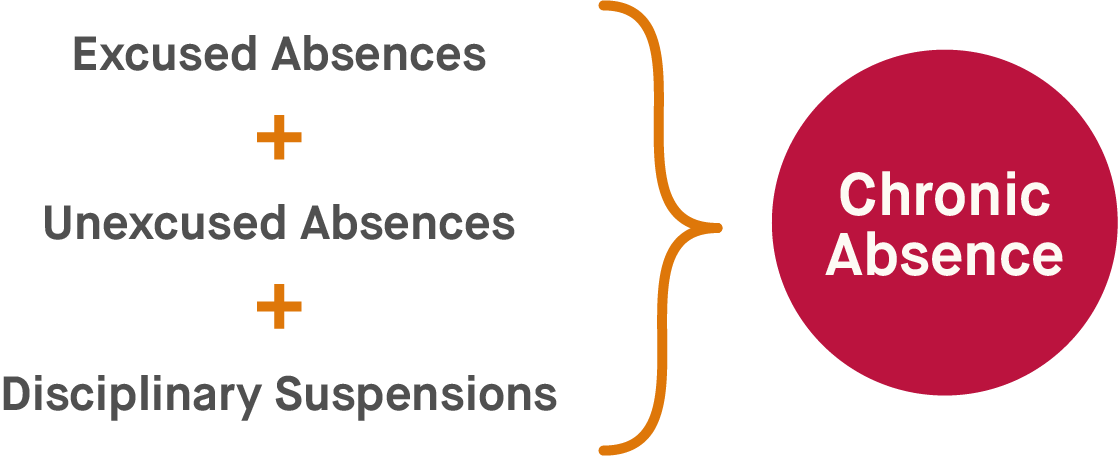Understanding Chronic Absence
What is Chronic Absence?
For school accountability purposes in Arizona, chronic absence is defined as missing 10% or more of school for any reason. In a typical school year of 180 days that meets five days per week, this means missing at least 18 days. Over the course of a full school year, missing just two days of school per month equates to being chronically absent.
Chronic absence counts all missed days of school, including unexcused absences, excused absences such as for illness, and suspensions. Chronic absence is missing so much school that a student is academically at risk.

Chronic absence is a student-level attendance indicator. A student’s attendance rate is calculated by dividing the student’s total days of attendance by the student’s total days of membership. If a student was enrolled in school for the first 60 days since the beginning of the school year and missed six days in those initial three months, that student would be on the path to being chronically absent (54/60 = 90% attendance rate = 10% missed instructional days).
Chronic Absence vs. Truancy
Chronic absence is different from truancy. Though both terms indicate problems with attendance, the terms are not interchangeable.
Truancy is a term that refers to unexcused absences only. Arizona legal statute defines truant as “an unexcused absence for a class period.” Solutions to truancy often involve more punitive measures and may use legal avenues to try and mitigate truancy and get individual students and their legal guardians to comply with school rules.
- Arizona Statute ARS § 15-802 charges guardians with the responsibility to ensure that their child attends school full-time and regularly. Guardians may be exempt from these obligations if the school principal/designee is satisfied that certain circumstances have been demonstrated, such as: the student has a physical/mental health condition that makes instruction impracticable, is enrolled in work training approved by ADE, is enrolled in an educational program provided by the state, is suspended or expelled, and for other reasons of nonattendance at public school are satisfactory to school principal/designee.
- Arizona Statute ARS § 15-803 defines “truant” as an unexcused absence for at least one class period. A “Truant child” is a child (ages 6-16) who is not in attendance during hours of school unless excused. Students are considered “habitually truant” if they are truant at least five days in a school year. Absences may be considered excessive when the number of absent days exceeds 10% of the number of required attendance days. A child who is habitually truant or who has excessive absences may be adjudicated an “incorrigible child.”
- Arizona Statute ARS-15-346 directs governing boards to adopt policies and procedures concerning students with chronic health problems to continue student learning while they are absent.
Unlike truancy, chronic absence focuses on students who miss school regularly whether the absences are excused or unexcused. Chronic absence is an indicator that shows the level at which students are missing instructional time and their opportunity to learn.
Instead of punishment for missed days, solutions to chronic absence involve working to understand the specific barriers to attendance and creating working solutions so that students can and will attend school.
Resource
For more guidance on excused or unexcused absences, see Arizona Department of Education’s Defining Excused Absences.
Chronic Absence Can Go Unnoticed
Chronic absence can often go unnoticed unless it is intentionally tracked. It is not a simple calculation of how many total students attend school on a given day or for a whole year.
Understanding chronic absence involves looking at the attendance rates of individual students consistently and regularly over time. The measure involves examining who is absent and how much. If there is not consistent attention given to tracking chronic absence early in the school year, opportunities to identify and support students who are falling behind as a result of missing school may go unnoticed.
Definitions of Attendance
Definitions of attendance are important to be able to measure and look at chronic absence effectively. Arizona requires daily attendance for in-person learning and distance learning.
While other states have legal definitions of “days in attendance” and chronic absence, Arizona does not currently have a legal definition of chronic absence outside of school accountability measures, and definitions of a “day in attendance” for both in-person and distance learning are left to local district discretion.
In Arizona, a day of attendance is shaped according to districts’ instructional time model design (ARS § 15-901.08).
Resource
Connecticut is often cited as a model for working to reduce chronic absence. See Connecticut’s definition of “in attendance” and its definition of chronic absence.
Impact of Attendance on Achievement
School attendance is significantly related to school achievement. Districts and schools with high rates of chronic absence often have lower achievement scores. Too many absences can keep students from reading at grade level by the end of third grade, which is a strong predictor of future academic success. Research shows that chronic absence in kindergarten and first grade can severely impact reading achievement.

The good news is that the converse is also true: preventing absences produces increases in early literacy outcomes. Based on a study conducted by Read On Arizona and Arizona State University, data analysis showed that a 1% increase in school-level attendance was associated with a 1.5% increase in students passing Arizona’s third grade English Language Arts assessment.
Chronic absence impacts a student’s ability to perform academically, and students who fall behind early are much less likely to graduate on time. Chronic absence in sixth grade is an early predictor for dropping out of high school. Evidence suggests that students are seven times more likely to drop out if they are chronically absent even just one year between grades 8 and 12. And chronic absence has been found to reduce the likelihood of post-secondary enrollment.
Research also shows that when chronic absence is high, it can impact the entire class and school, not just those students who are missing 10% or more days in a school year. High levels of chronic absence add to the stress and strain on teachers who have to continually deal with helping students catch up and maintain a positive and thriving learning climate for all. Teachers must change their approach to keep everyone on track. In addition, when students are absent it can increase discipline problems and does not allow them to build lasting relationships with their peers.
In addition, when the number of absent students increases in a class, the likelihood that other students will be absent increases. According to recent research from the University of Pennsylvania, when 10% of a student’s classmates are absent on a given day, that student is more likely to be absent the following day.
How is truancy treated in your school, district, or charter network? How is chronic absence addressed in your school, district, or charter network?
Resources
Summary of Key Research from Attendance Works
Everyone Graduates Center Brief from Johns Hopkins University
Chronic Absence vs. Truancy from Attendance Works
Read On Arizona’s Factors Related to Early Childhood Literacy study
